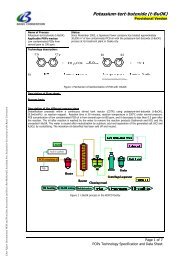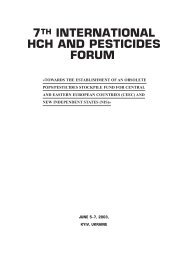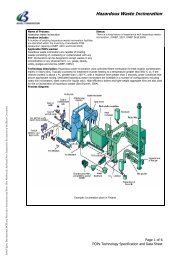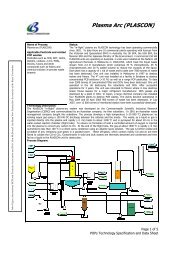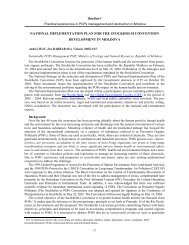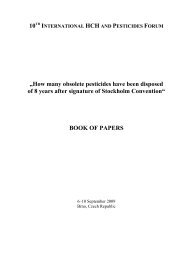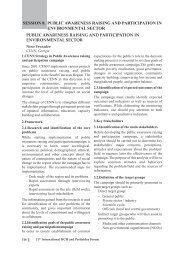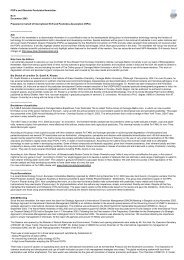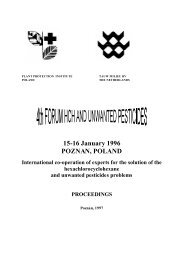contents - IHPA
contents - IHPA
contents - IHPA
Create successful ePaper yourself
Turn your PDF publications into a flip-book with our unique Google optimized e-Paper software.
POPS NEWSLETTER<br />
NO 23, JUNE 2012<br />
PREPARED ON BEHALF OF <strong>IHPA</strong><br />
Editor: Prof. Dr. Md. Mahbubar Rahman, Dean, Faculty of Fisheries, Bangabandhu Sheikh<br />
Mujibur Rahman Agricultural University (BSMRAU), Gazipur, Bangladesh,<br />
drmahbubarr@gmail.com<br />
Co-Editors:<br />
� Prof. Dr. Joao PM Torres, Biophysics Institute – UFRJ – Brazil, Rio de Janeiro, Brazil,<br />
mjptorres@biof.ufrj.br<br />
� Ms. Gulchohra Aliyeva, Lancaster University, Lancaster Environment Centre,<br />
g.aliyeva@lancaster.ac.uk<br />
� Dr. Michael Bittner, RECETOX, Masaryk, University Kamenice 3, Brno, CZ62500 Czech<br />
Republic, bittner@recetox.muni.cz<br />
� Dr. Jiri. Novak, RECETOX, Masaryk, University Kamenice 3, Brno, CZ62500 Czech Republic,<br />
novakj@recetox.muni.cz<br />
� Ondrej Mikes, MSc., RECETOX, Masaryk, University Kamenice 3, Brno, CZ62500 Czech<br />
Republic, mikes@recetox.muni.cz<br />
� Ms. Khatuna Akhalaia, Milieukontakt International, Georgia,<br />
khatunaakhalaia1@yahoo.com<br />
� Yeneneh T. Belayneh, PhD., USAID/OFDA, USA, ybelayneh@ofda.gov<br />
� Roland Weber, PhD, POPs Environmental Consulting, Ulmenstrasse 3, 73035 Göppingen,<br />
Germany, roland.weber10@web10 or roland.weber10@googlemail.com<br />
SUPPORT <strong>IHPA</strong><br />
The aim of this newsletter is to disseminate information in a cost-effective way on the Development<br />
taking place in the area of POPs as implicated in the Stockholm Convention and other pollutants of<br />
concern. It will cover, among others, the news on science and technology for disposal of obsolete<br />
stocks and remediation of POPs contamination, which might be of interest for commercial<br />
exploitation both in developed and developing countries. Special emphasis will be given to<br />
bioremediation, non-combustion related technologies, which will benefit developing countries. The<br />
newsletter will not go into technical details of selected scientific publications but only highlight<br />
salient features for the benefit of the readers. One can subscribe and read <strong>IHPA</strong> Newsletter<br />
(2 times/yr free of charge) at .
CONTENTS:<br />
1. COLLECTIONS OF RECENT PROGRESS IN AZERBAIJAN (QUOTED FROM PRESS RELEASES)<br />
Gulchohra Aliyeva<br />
(I) A success story: Azerbaijan Government takes action to deal with Obsolete Pesticides<br />
(II) MEP Dan Jørgensen visits Azerbaijan in March 2012!<br />
John Vijgen<br />
(III) Clean Ukraine from the Obsolete Pesticides (OP) by the End of 2011<br />
(IV) BHOPAL GIZ 2012<br />
2. BHOPAL WASTE TO BE INCINERATED IN GERMANY<br />
By Jade in Brighton<br />
3. APPROVAL TO MADHYA PRADESH GOVERNMENT TO DISPOSE OF 350 METRIC TONNES OF UNION<br />
CARBIDE TOXIC WASTE IN GERMANY<br />
4. INDIA DEAL TO BURN WASTE LEFT AFTER BHOPAL DISASTER<br />
5. PILOT REMEDIATION OF OBSOLETE PESTICIDES IN VIETNAM<br />
6. OBSOLETE PESTICIDES LEGACY PROBLEMS IN MONGOLIA REMAIN UNSOLVED<br />
7. ENVIRONMENTAL MOVEMENT IN ALBANIA IN A EUROPEAN CONTEXT<br />
8. ENVIRONMENTAL MOVEMENT ALBANIA<br />
9. BROCHURE ON ELIMINATION OF RISKS FROM OBSOLETE PESTICIDES IN MOLDOVA<br />
10. NATIONAL CONFERENCE “ACT NOW”<br />
11. CONTRIBUTIONS FROM BALA SUGAVANAM<br />
(I) Church and Pesticide Safety<br />
(II) Malaria :<br />
(III) Weed killer linked to birth defects in Britain<br />
(IV) Tyres illegally sent to Vietnam<br />
(V) (5) 1PPB of domestic herbicide contaminations causes £300 loss to a company specializing in<br />
vegetable seedlings<br />
12. SOME IMPORTANT OBSERVATIONS ON PESTICIDES IN AFGHANISTAN<br />
Md. Mahbubar Rahman<br />
13. DRIN´S CONTAMINATION IN BRAZIL<br />
Torres, JPM and Manhães-Rocha, DA<br />
14. ENVIRONMENT AND SECURITY INITIATIVE<br />
OSCE<br />
15. FOLLOW-UP ON HCB CONTROL IN UKRAINE:<br />
Tomasz Stobiecki
1. COLLECTIONS OF RECENT PROGRESS IN AZERBAIJAN (QUOTED FROM PRESS RELEASES)<br />
Gulchohra Aliyeva<br />
I. A success story: Azerbaijan Government takes action to deal with Obsolete Pesticides<br />
In October 2011 – May 2012, FAO-Green Cross-<strong>IHPA</strong>-Milieukontakt International and UNEP<br />
Ecores NatCom have implemented the pilot project “Awareness raising and Inventory of<br />
obsolete pesticides” in Azerbaijan within GEF programme “Capacity Building on Obsolete<br />
Pesticides (OP) in Eastern European, Caucasus and Central Asia (EECCA) countries”.<br />
The UNEP-Ecores NatCom has successfully organised public awareness seminars in Baku,<br />
Salyan, Ganja and Kurdamir with support of the International Resource Complex of<br />
Azerbaijan (IRC public libraries in these cities), the Ministry of Agriculture of the Republic of<br />
Azerbaijan and the local executive authorities. The project also included analysis of<br />
soil/unknown pesticide samples collected at several former pesticide storage warehouses<br />
(OP sites) in Lancaster Environment Centre of Lancaster University (UK). In support to the<br />
project implementation, on 17 January 2012 the Government of Azerbaijan has set up the<br />
fact-finding Inventory Commission comprised of the experts of the Ministry of Agriculture,<br />
the Ministry of Ecology and Natural Resources, the Ministry of Public Health Services, the<br />
Ministry of Emergency Situations, the Ministry of Finance, the Ministry of Economic<br />
Development and the State Committee of Land and Cartography (order of the Cabinet of<br />
Ministers of the Republic of Azerbaijan No. 31/5-46 dated 14 December 2011). The objective<br />
of the commission was to organize field trips to the former agrochemical storage facilities in<br />
different regions of Azerbaijan, to reveal and report quantities of banned and obsolete<br />
pesticides, details of contaminated sites, and provide recommendations to the Government<br />
of Azerbaijan on further actions to reduce the exposure to the population through proper<br />
practices of OP safeguarding, disposal and remediation activities. The inventory field trips<br />
have been completed within the period of 26 January - 5 March 2012. The detailed OP<br />
inventory report was submitted to the Deputy Prime Minister of Azerbaijan along with<br />
recommendations. The findings of the Inventory Commission have also been entered into<br />
the Pesticide Stock Management System (PSMS) developed by UN FAO. The Action Plan for<br />
mitigation/elimination of OPs is under preparation by the commission experts. The Chairman<br />
of the Inventory Commission is Mr. Aladdin Eyvazov, Deputy-Chief of State Phytosanitary<br />
Control Service of the Ministry of Agriculture of Azerbaijan, and the Deputy Chairman is Ms.<br />
Khoshqadam Alasgarova, Chief of Plant Protection and Pest Control Section of Phytosanitary<br />
Control Service of the Ministry of Agriculture of Azerbaijan.<br />
II. MEP Dan Jørgensen visits Azerbaijan in March 2012<br />
Mr. Dan Jørgensen, Member of the European Parliament, Vice Chair of the Committee for<br />
Environment, Public Health and Food Safety, visited Azerbaijan from 8 to 11 March 2012,<br />
and met several Members of the Milli Majlis (Parliament), and Mr. Ismat Abasov, the<br />
Minister of Agriculture, as well as Dr. Shahin Panahov, Chairman of the UNEP-Ecores<br />
National Committee working on POPs issues in Azerbaijan, to discuss the pesticide activities<br />
in the country. At the end of the meetings, a group has visited the refurbished temporary<br />
obsolete pesticide storage site in Jangi village located in ~50 km from Baku.<br />
1
MEP Dan Jørgensen meeting Mr. Ismat Abasov, the Minister of Agriculture of the Republic of Azerbaijan<br />
III. Clean Ukraine from the Obsolete Pesticides (OP) by the End of 2012<br />
John Vijgen<br />
The Government of Ukraine has put through the Ministry of Environment Protection and<br />
Natural Resources the task to completely clean Ukraine from the obsolete pesticides (OP) by<br />
the end of the year 2012.<br />
It is well-known that the Israelian Company SI Group Consort Ltd exported from Ukraine<br />
more than 25K MT of different sort of toxic wastes such as obsolete pesticides, MNCB and<br />
HCB.<br />
If one would decide to place the trucks which have taken this dangerous waste out from<br />
Ukraine in 2011 behind each other, it will form a row of nearly 14 km.<br />
In accordance with National plan, 22 regions of Ukraine will have to be completely cleaned<br />
from obsolete pesticides. Particularly talks were held about Vinnitskaya, Volynskaya,<br />
Zhytomyrskaya, Zakarpatskaya, Zaporozhskaya, Kirovogradskaya, Luganskaya,<br />
Nikolaevskaya, Odesskaya, Poltavskaya, Rovenskaya, Sumskaya, Khersonskaya,<br />
Khmelnitskaya, Cherkasskaya, Donetskaya, Kievskaya, Lvovskaya, Kharkovskaya,<br />
Dnepropetrovskaya oblasts and Crimea (Autonomic Republic).<br />
In accordance with the signed contract between MoEP and SI Group Consort Ltd, the<br />
Israelians have already exported 296,024 MT of OPs from Donetskaya oblast, 526,322 MT of<br />
OP from Kievskaya oblast, 339, 627 MT of OP from Lvovskaya oblast, 1070,183 MT of OP<br />
from Kharkovskaya oblast and 391,035 MT of OP from Dnepropetrovskaya oblast during this<br />
year.<br />
The repackaging works wese completed on the 14-15th of May.<br />
The last truck left Kharkovskaya oblast on the 23rd of May.<br />
And the cleaning of Ukraine from toxic wastes will keep going on<br />
2
IV. BHOPAL GIZ 2012:<br />
http://www.dw.de/dw/article/016010126,00.html<br />
A German institution was selected by the Indian government to carry out a waste removal<br />
operation from a factory in Bhopal, the site of a deadly gas leak that killed several thousand<br />
people in 1984.<br />
The Indian government confirmed a plan in the mix with the German Society for<br />
International Cooperation (GIZ) on Friday to dispose of 350 tons of toxic waste from a<br />
factory in Bhopal where a gas leak killed thousands in 1984.<br />
Final details in the contract between the GIZ, the Indian state of Madhya Pradesh, and the<br />
Indian federal government are expected to be completed in the next three or four weeks.<br />
The Madhya Pradesh Gas Relief and Rehabilitation Minister, Babulal Gaur, said the Indian<br />
government would pick up the 250 million rupee (3.6 million euros, $4.5 million) tab for<br />
flying the industrial waste to Germany.<br />
The contaminated material, which is solid and contains pesticides and heavy metals, is not<br />
connected to the methyl isocyanate gas that leaked from the factory in 1984. It is from<br />
chemical dumps that occurred between 1969 and 1984, which are believed to have been<br />
contaminating ground water in the area. The water is used by nearby slums and is suspected<br />
to have caused serious health problems among residents.<br />
"India lacks the capacities to dispose of the soil properly," said the GIZ's Hans Herrmann<br />
Dube. "We are starting to draft detailed disposal plans, based on the premise that safety is<br />
more important than speed."<br />
GIZ has not said where the hazardous waste will end up, but it did note that facilities in<br />
Germany would allow for the waste to be disposed of safely without danger to public health<br />
or the environment.<br />
mz/pfd (EPD, dpa, AFP)<br />
http://www.bhopal.org/2012/05/bhopal-waste-to-be-incinerated-in-germany/<br />
3<br />
back
2. BHOPAL WASTE TO BE INCINERATED IN GERMANY<br />
May 25 2012 by Jade in Brighton<br />
The Group of Ministers (GoM) for the Bhopal gas tragedy has drawn up plans for the 350<br />
metric tonnes of waste remaining inside the abandoned Union Carbide premises to be<br />
exported to Germany for incineration.<br />
The final go ahead for the proposals has been decided upon at the GoM meeting on the<br />
8 th June 2012. Representatives from the German Academy for International Cooperation<br />
(GIZ), the German agency who oversaw the disposal met with the GoM in Bhopal on May<br />
17th 2012. GIZ had previously quoted the Madhya Pradesh Government the price of 9<br />
million Euros to incinerate the waste in Hamburg, northern Germany. This is far less than<br />
quotes for the disposal of the waste in India.<br />
The Gas Tragedy Relief and Rehabilitation Minister for Madhya Pradesh, Babulal Gaur,<br />
announced that the Union Environment and Forests Ministry had consented to the<br />
amendment of disposal rules earlier this week at a meeting in Delhi. “We have already<br />
discussed the issue with the representatives of the German company. It will happen soon,”<br />
stated Babulal Gaur confidently.<br />
Abandoned waste left at the site © Samuel Benoit<br />
Multiple survivors’ organizations have stressed the need for a long-term view regarding the<br />
waste disposal. These groups emphasize that the 350 tonnes of waste that have been<br />
proposed for disposal are by no means all of them, and that in fact, a further 27,000 tonnes<br />
of waste is buried in unlined pits and under solar evaporation ponds around the 67 acre<br />
factory premises. The waste in question originates from regular dumping of chemicals<br />
between 1969 and 1984 by Union Carbide at the plant in Bhopal, prior to the leak of the<br />
deadly methyl isocyanate gas that claimed the lives of 20,000 people.<br />
4
Campaigners have additionally voiced concerns that incinerating the waste outside of India<br />
will be done by be w Dow chemical, who bought Union Carbide in 2001, of the responsibility<br />
for the on-going disaster in Bhopal. Removing the toxic waste would provide little<br />
consolation for the thousands of people who continue to suffer as a result of the gas leak<br />
and its aftermath.<br />
Rusting Hulk left by Union Carbide © Samuel Benoit<br />
In previous years proposals to dispose of the waste in other cities in India have been<br />
contemplated, initially at a facility close to Nagpur, and later near Taloja at Mumbai Waste<br />
Management. These plans to incinerate the waste in India were met with anger from local<br />
people living in the proposed areas, who expressed worries over another potential disaster.<br />
Residents are relieved with the decision to incinerate the waste elsewhere. “We are happy it<br />
is not happening in Madhya Pradesh,” Bhopal activist Rachna Dhingra agrees. “But the<br />
authorities must be careful that the process of transport of this waste from Bhopal to the<br />
port be done carefully.”<br />
The plan is for the waste to be airlifted to the facility in Hamburg by GIZ. Plans to move the<br />
waste abroad came from suggestions that the international community may be better<br />
equipped to deal with such large quantities of hazardous waste.<br />
Wall of the abandoned factory © Samuel Benoit back<br />
5
3. APPROVAL TO MADHYA PRADESH GOVERNMENT TO DISPOSE OF 350 METRIC TONNES OF<br />
UNION CARBIDE TOXIC WASTE IN GERMANY<br />
Published Friday, June 8, 2012, 17:33 IST<br />
Place: New Delhi, Agency: PTI<br />
A Group of Ministers (GoM) on Friday gave its approval to Madhya Pradesh government to<br />
dispose of 350 metric tonnes of Union Carbide toxic waste in Germany.<br />
As per the decision, the Centre will pay Rs 25 crore towards the cost of airlifting the waste<br />
which will be removed within a year.<br />
Madhya Pradesh Bhopal Gas Tragedy, Relief and Rehabilitation Minister Babulal Gaur said<br />
that the GoM under the chairmanship of Union Home Minister P Chidambaram has asked<br />
the state government to prepare an agreement within two weeks' time.<br />
"The proposal has been agreed to. The waste will be disposed of in Germany. The cost of Rs<br />
25 crore for airlifting the toxic material will be borne by the central government. The whole<br />
procedure of removing the waste will be completed within a year," Gaur told reporters here<br />
after the meeting.<br />
He said the state government will submit the agreement to the Centre before the next<br />
meeting.<br />
According to Madhya Pradesh government officials, the disposal would be carried out by<br />
German agency-GIZ IS.<br />
About 346 MT toxic waste is lying within the premises of the erstwhile M/s Union Carbide<br />
India Ltd (UCIL) at Bhopal.<br />
The worst-ever industrial disaster had taken place at the Union Carbide plant on the<br />
intervening night of December 2-3, 1984.<br />
According to a government data, a total compensation of over Rs 3,000 crore has been given<br />
in 5,295 cases of death, 4,902 cases of permanent disability, 5,27,894 cases of minor injury<br />
and 35,455 cases related to temporary disability among others.<br />
Gaur, along with some senior state government officials, had on May 17 held a discussion<br />
with GIZ IS in Bhopal.<br />
Today's GoM was attended by Union Urban Development Minister Kamal Nath, Minister of<br />
Health and Family Welfare, Ghulam Nabi Azad and Minister of Human Resource<br />
Development Kapil Sibal besides some senior officials of the central and state government<br />
departments.<br />
6<br />
back
4. INDIA DEAL TO BURN WASTE LEFT AFTER BHOPAL DISASTER<br />
Friday, 08 June 2012 17:01 GMT, New-Delhi, AFP<br />
The Indian government on Friday approved a proposal for a German environmental agency<br />
to dispose of over 350 tonnes of waste produced by the Bhopal factory where a gas leak<br />
killed thousands in 1984.<br />
Home Minister P. Chidamabaram and other senior ministers met in New Delhi to clear a deal<br />
in which the waste will be taken by air to Germany for incineration.<br />
"The ministers have given a green signal," a<br />
senior home ministry official told AFP,<br />
declining to be named.<br />
"The German Society for International<br />
Cooperation (GIZ) has been awarded the<br />
contract to transport the waste to Germany<br />
for disposal," he said.<br />
The GIZ, based in Bonn, is a governmentrun<br />
enterprise that works on international<br />
environmental issues and sustainable<br />
development.<br />
Bhopal was the scene of the world's worst industrial accident in 1984 when the pesticide<br />
factory leaked toxic gas into nearby slums, killing thousands instantly and tens of thousands<br />
more over the following years.<br />
Tonnes of chemical waste previously produced by the plant were left in pits around the site,<br />
polluting local water supplies.<br />
Residents have been campaigning for years for the thorough clean-up of the factory and the<br />
surrounding area.<br />
GIZ, which will be paid by the Indian government, will negotiate details of the deal with the<br />
Madhya Pradesh state government, of which Bhopal is the capital.<br />
Many experts believe that the presence of toxic waste has resulted in a high prevalence of<br />
birth defects and illnesses among successive generations of people living near the plant.<br />
The accident was blamed on the factory's operators, Union Carbide, a US chemical group<br />
later bought by Dow Chemical.<br />
7<br />
back
5. PILOT REMEDIATION OF OBSOLETE PESTICIDES IN VIETNAM<br />
Posted on March 20, 2012 in Capacity Building, Obsolete Pesticides Project, Public<br />
Participation<br />
As many other developing countries, Vietnam is facing legacy problems with obsolete and<br />
POPs pesticides. In the case of Vietnam many of the former storages are emptied in a cleanup<br />
campaign and send for destruction to a modern cement kiln. But people have buried the<br />
stocks as well in the past because they did not know what to do with them. As a result the<br />
pesticides are mixed with soil and it is more difficult to collect and destruct them.<br />
POPs remediation Vietnam<br />
The Dutch Environmental Consultant Tauw implements a UNDP project to write a handbook<br />
with guidelines for Obsolete and POPs pesticides remediation based on the practical<br />
example of 10 pilot remediation sites.<br />
For this assignment Tauw established in 2011 a consortium of the International HCH and<br />
Pesticides Association (<strong>IHPA</strong>), Milieukontakt International and the independent legal expert<br />
Helle Husum. The drafting of the handbook is well underway and pilot remediation has taken<br />
place on the first location: under the management of Berto Collet from Tauw a bunker with<br />
25 tonnes of Lindane and DDT was emptied.<br />
Boudewijn Fokke from Tauw is drafting the handbook and uses the extensive experience of<br />
John Vijgen from <strong>IHPA</strong> to review the result. Thus far the handbook contains 7 environmental<br />
management plans for the pilot remediation sites. Helle Husum writes a gap analysis of the<br />
obsolete and POPs pesticides legislation in Vietnam and Wouter Pronk of Milieukontakt<br />
writes guidelines for stakeholder involvement at local level. This in order to make sure that<br />
the local people that live close to the sites are well informed before a remediation starts,<br />
know how to minimize health risks and avoid mistakes, accidents and protests around the<br />
project.<br />
8<br />
back
6. OBSOLETE PESTICIDES LEGACY PROBLEMS IN MONGOLIA REMAIN UNSOLVED<br />
Posted on January 5, 2012 in Mongolia. Obsolete Pesticides, Obsolete Pesticides Project<br />
Mongolia’s economy is booming. International investments for exploration of the extensive<br />
mineral deposits resulted in a growth rate of close to 20 percent in the fourth quarter of last<br />
year. But pesticides problems from the past – when the country was a Soviet satellite –<br />
remain unsolved.<br />
POPs storage centre in Uvurkhangai province<br />
A mission form Milieukontakt and the International HCH and Pesticides Association (<strong>IHPA</strong>) to<br />
Mongolia in October 2011 revealed that on different locations in the country obsolete stocks<br />
of POPs pesticides are stored under substandard conditions. The scale of the problem,<br />
however, is difficult to establish without a further research.<br />
During a seminar with Milieukontakt and <strong>IHPA</strong> and Regional Inspectors from the Plant<br />
Protection and Quarantine Department of the Ministry of Agriculture in Ulan Bataar it was<br />
agreed that the inspectors would look into the matter in further detail and search for not<br />
administered stock of obsolete and POPs pesticides. This in order to get a first indication of<br />
the scale and extend of the problems in Mongolia.<br />
Unfortunately the inspectors thus far were not able to provide Milieukontakt and <strong>IHPA</strong> with<br />
further details of amounts of obsolete and POPs pesticides in their home provinces.<br />
9
It will be important to set up structural cooperation with the Ministry of Environment, the<br />
Ministry of Agriculture and other stakeholders in order to get the facts straight about the<br />
scale of the problem in Mongolia and prepare next steps to eliminate the acute risks on<br />
human health and the environment stemming from obsolete and POPs pesticides.<br />
A mission report will be available after Milieukontakt and <strong>IHPA</strong> received comments on the<br />
outcomes from the Mongolian Ministry of Environment and the Ministry of Agriculture.<br />
The Milieukontakt and <strong>IHPA</strong> mission to Mongolia was financed as part of the FAO, Green<br />
Cross Switzerland, <strong>IHPA</strong> and Milieukontakt implemented and GEF-funded project: Capacity<br />
building on Obsolete and POPs Pesticides in Eastern European, Caucasus and Central Asian<br />
(EECCA) countries.<br />
7. ENVIRONMENTAL MOVEMENT IN ALBANIA IN A EUROPEAN CONTEXT<br />
Posted on December 22, 2011 in Albania, Capacity Building, Country Publication,<br />
Uncategorized<br />
In a new publication Milieukontakt describes lessons learned about building civil society for<br />
the environment. The publication is based on more than 20 years experience in this field in<br />
over 30 countries. It is published in the framework of the project, ‘Serving Albanian<br />
Environmental Civil Society in Environment’ (SACSIE), conducted in Albania from 2007 to<br />
2010.<br />
8. ENVIRONMENTAL MOVEMENT ALBANIA<br />
GREEN AGENDA ON THE WESTERN BALKANS: FINAL PUBLICATION<br />
Posted on December 22, 2011 in Uncategorized<br />
In February 2007 the program Green Agenda in The Western Balkans began with the<br />
intention to develop Green Agenda processes in at least 12 communities in 6 countries.<br />
Nobody knew if this process would work in a region so much affected by recent conflicts.<br />
The big question was: Are local citizens in the region capable of cooperation outside their<br />
own circle and can they look at the future based on values developed in the past?<br />
Now, 4 years later, a Green Agenda document has been adopted in 16 communities, and 7<br />
more have gone through the process of development of Green Agenda documents. Local<br />
citizens have worked together to define values and develop pilot projects within a strategy<br />
based on these values. In each country local project managers, platforms, trainers and local<br />
working groups have been, and still are, committed to support the development of a true<br />
participative democracy of which Green Agenda is one of the most advanced, bottom up,<br />
approaches.<br />
10<br />
back<br />
back<br />
back
9. BROCHURE ON ELIMINATION OF RISKS FROM OBSOLETE PESTICIDES IN MOLDOVA<br />
Posted on October 3, 2011 in Obsolete Pesticides, Public Participation Publication<br />
Milieukontakt is co-author of the recent brochure The Eliminators in Moldova, published<br />
within the GEF/FAO project Capacity Building on Obsolete and POPs Pesticides in Eastern<br />
European, Caucasus and Central Asian Countries. The brochure was prepared to serve as an<br />
example and inspiration for those who will work or are already working on problems related<br />
to obsolete pesticides and Persistent Organic Pollutants (POPs), irrespective whether they<br />
work for national or local governments, NGOs, scientific organisations, donors or the private<br />
sector.<br />
In the period 2005-2006, Milieukontakt and partners <strong>IHPA</strong> and Tauw set up a project in the<br />
Hincesti rayon in Moldova in order to safeguard 100 tonnes of obsolete pesticides as a pilot<br />
project, while simultaneously running public awareness campaigns and securing the<br />
involvement of local stakeholders. Milieukontakt has since then executed similar projects in<br />
Georgia, Kyrgyzstan and Ukraine and is still actively involved in elimination of risks from<br />
obsolete pesticides, most specifically in Eastern European, Caucasus and Central Asian<br />
(EECCA) countries.<br />
The brochure has recently been distributed during the 11th Intenational HCH and Pesticides<br />
Forum in Azerbaijan. You can download a copy here:<br />
The Eliminators in Moldova-brochure, Cover pages-The Eliminators in Moldova<br />
If you would like to receive a hard-copy, please contact Sandra Molenkamp (at<br />
Ms.molenkamp@milieukontakt.nl). In two months time the brochure will also be available in<br />
Russian.<br />
10. NATIONAL CONFERENCE “ACT NOW”<br />
Posted on October 28, 2010 in Albania Project<br />
Milieukontakt International –local office Albania organized on 27 th October 2010 National<br />
Conference as a closure of National Campaign – Act Now! Representatives from Central<br />
Government, Foreign bodies, civil society organizations, media, etc, participated in the<br />
meeting. Event was greeted by Mr. Fatmir Mediu, Minister of Environment, Forest and<br />
Water Administration, Mrs. Noeke Ruiter from Netherlands Embassy and REC Albania.<br />
11<br />
back
Campaign was running for more than one year expanded country wide and involving several<br />
stakeholders from central and local government, state institutions, civil society, focusing on<br />
water, air, waste and public participation problems and presenting at the same time<br />
initiatives undertaken and positive examples for improvement of these issues.<br />
Campaign was characterized by diversity in activities implemented, materials produced,<br />
topics dealt and cities/communes involved.<br />
Environmental organizations guaranteed in the Conference their engagement in<br />
environment protection, contributing in improvement of the situation in the country as<br />
stated in the Declaration below.<br />
11. CONTRIBUTIONS FROM DR. BALA SUGAVANAM<br />
(1) Church and Pesticide Safety<br />
Can public awareness to pesticide safety be raised using religion? In Ghana the Presbyterian<br />
Church through its agency Agricultural Services has raised serious concerns about the<br />
increasing rate at which people suffer and even die through poisoning from pesticides. The<br />
Church started a campaign “misuse of pesticides in Ghana, the time to act now”. The<br />
campaign stressed the consequences associated with mis-use and wrong application of<br />
chemicals and appealed to all stakeholders to make a collective effort at addressing the<br />
situation before it reaches a crisis point. One of the campaign leaders cited that even though<br />
the use of DDT had been banned in the country it is still being used illegally. He also<br />
informed the gathering that mis-use of agrochemicals was responsible for most of the cases<br />
of impotence among the male population in most of the country's farming communities.<br />
According to the church, the WHO estimated that 1.5 million cases of pesticide poisoning<br />
occur every year, resulting in 20,000 fatalities among agricultural workers most of whom<br />
were in developing countries such as Ghana. Church involvement will definitely increase<br />
public awareness to Chemical hazards but combining scientific facts and developments<br />
should not be blurred by spiritual message alone. (source: Chronicle on Saturday, Accra,<br />
26.11.11.)<br />
(2) Malaria:<br />
Once again April 25 is the anniversary of WHO's Roll Back Malaria also called Malaria Day<br />
and on this anniversary Financial Times, London usually comes up with a special issue on<br />
health. We are providing some interesting developments in the control of this dreadful and<br />
complicated disease which the whole world is fighting. Let us start at the very beginning.<br />
Malaria meaning disease from bad air originates from Italian malaria. It was Sir Ronald Ross<br />
in 1899 who determined the bite of anopheles mosquito spread malaria. It was in Sierra<br />
Leone stagnant foul water was an ideal breeding ground for mosquitoes. Sir Ronald raised<br />
funds privately and used a group of 50 to clean all the stagnant water and wrote in his 1902<br />
book “Mosquito Brigades and how to organise them”. More than 110 years later, Sierra<br />
Leone painfully stays similar as the disease of the poor (source BBC 25.4.12)<br />
Rob Newman, Head of the Malaria Programme at WHO says “we continue to make good<br />
progress against a formidable foe”. There has been greater access and evidence of impact<br />
”In general there is a downward trend driven to large part by funding and delivery of three<br />
potent tools artemisinin-combination therapy(ACT), long lasting insecticide treated bed nets,<br />
12<br />
back
and a rapid diagnostic tests. In addition large scale tests are in progress on Malaria vaccine<br />
(RTSS) developed by Glasgow Smith Kline (GSK).<br />
On the other hand, ACT is coming across resistance in Thai/Cambodia/Myanmar border<br />
areas. In addition, resistance to treated bed nets are being reported. DDT alternative<br />
bendiocarb is proving effective. BASF has come up with a modified formulation of<br />
agricultural insecticide chlorfenapyr. This disrupts the energy producing mitochondria in<br />
insect cells, whereas the pyrethroids attack insect nervous system. There are also genetically<br />
modified mosquitoes being investigated at John Hopkins Institute, Baltimore and Imperial<br />
college London.<br />
India's top drug maker Ranbaxy Laboratories has launched a new malaria treatment drug,<br />
Synriam, on the occasion of the World Malaria Day. The country's first anti-malaria drug<br />
would treat Plasmodium falciparum malaria in adults, the company said. It is said that the<br />
new drug was approved by Indian authorities for sale in India and conformed to the<br />
recommendations of the World Health Organisation (WHO).The WHO estimates that malaria<br />
kills about 15,000 people annually in India. But the Lancet, one of the world's leading<br />
medical journals, says that figure is hugely underestimated. It says more than 205,000<br />
people die of malaria every year in India.<br />
3 rd Century AD, Chinese Technology helps revolutionary Malaria ACT that is saving millions<br />
of lives.<br />
The interesting Chinese achievement, which is saving millions of people in developing<br />
countries using artemisinin-combination therapy(ACT) has links to 3 rd Century Chinese<br />
technology. The story is very interesting to see how the work carried out by Chinese scientist<br />
You You Tu and her team have transformed malaria treatment — taking a clue from 1700<br />
years old traditional knowledge to modern medical therapy.<br />
More than 40 years ago, amidst the upheaval and turmoil of the Cultural Revolution in<br />
China, and against the backdrop of the Vietnam war, hundreds of Chinese scientists<br />
embarked on an ambitious effort to find a drug that would conquer drug-resistant malaria.<br />
The result was the discovery of artemisinin, a compound found in plants, which, with its<br />
derivatives, is now widely used around the world to treat the disease. This year, a highly<br />
prestigious Lasker Award went to Youyou Tu, an 81-year-old Chinese scientist who played a<br />
key part in that discovery.<br />
In the midst of the Vietnam war, another desperate battle was being fought against<br />
Plasmodium falciparum, the most deadly of the malaria-causing parasites which had become<br />
resistant to the drug chloroquine. The U.S. came up with another drug to clear the parasite<br />
from the body — mefloquine. North Vietnam, for its part, appealed to China for help in<br />
fighting this disease.<br />
In response, on instructions from Chairman Mao Zedong and Premier Zhou Enlai, the<br />
Chinese government organised a meeting in Beijing on May 23, 1967 to discuss the problem.<br />
A secret nationwide programme, known as project 523, was then launched, involving over<br />
500 scientists from about 60 different laboratories.<br />
Prof. Tu and her colleagues began by scouring the literature on traditional Chinese medicine,<br />
scrutinising ancient texts and folk remedies. They investigated more than 2,000 Chinese<br />
herbal preparations, of which 640 appeared promising. Of these, some 380 extracts<br />
involving about 200 herbs were chosen for testing in mice. Unfortunately, “progress was not<br />
smooth, and no significant results emerged easily,” she writes in her article. The turning<br />
13
point came when an extract from a plant known to the Chinese as Qinghao (Artemisia annua<br />
or sweet wormwood) “showed a promising degree of inhibition against parasite growth.”<br />
But subsequent experiments came up with much lower levels of inhibition. Prof. Tu came to<br />
the conclusion that this could be due to problems in extracting the active ingredient. She<br />
found a clue in an ancient Chinese text, The Handbook of Prescriptions for Emergency<br />
Treatments by Ge Hong that goes back some 1,700 years.<br />
The text recommended soaking Qinghao in water, then wringing out the juice and drinking<br />
it. This sentence gave Prof. Tu the idea that the heating involved in the conventional<br />
extraction step they had used might have destroyed the active components, and that<br />
extraction at a lower temperature might be necessary to preserve antimalarial activity.<br />
Consequently, they switched to a lower-temperature extraction method. Still the extract was<br />
toxic. That problem was taken care of by purifying the extract to remove an acidic portion<br />
that had no anti-malarial activity. The remaining neutral extract, given the label ‘extract<br />
number 191,' could completely clear the parasites when tested in mice and monkeys.<br />
Prof. Tu presented the work at a project 523 meeting at Nanjing in March 1972. That same<br />
year, her group identified “a colourless, crystalline substance” as the active chemical<br />
compound. They called it Qinghaosu, which means the ‘basic element' in Qinghao. The world<br />
would come to know it as artemisinin. (source The Hindu, October 2011).<br />
It is interesting that recently scientists in India are reporting that extracts of more than 200<br />
organisms including different species of marine fungi, seaweeds, mangroves, sponges,<br />
cnidarians, molluscs, echinoderms and ascidians were screened during the first two phases<br />
of the project, which began in 2004. About 25 organisms showed the presence of antimalarial<br />
activity against resistant malaria parasites.<br />
(3) Weed killer linked to birth defects in Britain<br />
At least nine babies born to mothers living within a few hundred yards of each other in<br />
North fleet, Kent have suffered gastroschisis a condition that causes the digestive system to<br />
grow outside the abdomen. The women in Kent think that atrazine a toxic chemical widely<br />
used as a herbicide but banned by the European Union in 2004 could be to blame. It was<br />
found that water in the area contained dangerous levels of atrazine. In the USA there is a<br />
case going on to secure $333m payout to victims. US research group has established a link<br />
between exposure to atrazine and an increased prevalence of gastroschisis. Atrazine has<br />
been in use for more than 50 years and the manufacturers insist it is entirely safe. Southern<br />
Water which supplies water in the area acknowledged that atrazine was found in 2008 but<br />
said tap water came from a variety of sources and any pollutant would be heavily diluted.<br />
(Source Irish Times, April, 2012.)<br />
(4) Tyres illegally sent to Vietnam.<br />
Investigations show that used tyres are being shipped from Ireland to Britain and Holland<br />
for onward transport to Vietnam. Vietnam has banned the import of waste tyres in 2007.<br />
Waste tyres have become a significant cause of pollution in Vietnam where they are illegally<br />
dumped in rain forests or burned with other wastes which causes the release of organic<br />
pollutants including POPs and also cadmium, lead etc. Companies shipping waste tyres<br />
illegally from Britain make 50 cents per tyre equal to a profit of €1,215 per container. They<br />
are shipped as export for use in construction of motorway embankments. (Source : Irish<br />
Times, April 2012).<br />
14
(5) 1PPB of domestic herbicide contaminations causes £300 loss to a company<br />
specializing in vegetable seedlings<br />
A Yorkshire company in the UK selling special vegetable seedlings using special peat compost<br />
reported that they lost vegetable seedlings worth around £300 million .During preparation<br />
of special peat culture it was contaminated with domestic herbicide at a concentration of 1<br />
part per billion.. This affected the seedlings grown under special conditions. (Source: BBC<br />
Farming).<br />
12. SOME IMPORTANT OBSERVATIONS ON PESTICIDES IN AFGHANISTAN<br />
Md. Mahbubar Rahman<br />
Distribution, Marketing and Use of Pesticides:<br />
� The distribution, marketing and use of pesticides are not regulated by any legal<br />
framework.<br />
� According to interviews at the meeting with pesticide dealers, at present 100 brands of<br />
pesticides are marketed and used in Afghanistan. However, during the visits to the<br />
shops, list of 54 brands of pesticides could be collected. Those enlisted pesticides<br />
comprised 27 active ingredients.<br />
� Those pesticides belong to different classes such as organophosphate, carbamate,<br />
synthetic pyrethroid, organochlorine, cyclodiene etc., and most of them fall under WHO<br />
toxicity class II (14 a.i) followed by class U (7 a.i.s) and class III (5 a.i.s) while the lowest<br />
to Class Ia (1 a.i.). The most commonly used pesticides are dimethoate, lambda<br />
cyhalothrin, endosulfan, dicofol, sulfur, zinc phosphide, aluminum phosphide, mancozeb<br />
etc. BHC has been largely used for the locust control in the southern belt since long back<br />
but the pesticide dealers and sellers denied its recent marketing.<br />
� Most of the 30 farmers interviewed at the Farmers Field Schools use pesticide product<br />
without knowing its name, just depending upon what they get from the pesticide<br />
retailers/dealers. Sometime they seek advice from the local agriculture department but<br />
finally they buy what the pesticide dealers sell to them. In a crop season, more than 4<br />
times they spray a crop and harvest the crops even within 2-3 days of spraying.<br />
� The pesticides are mostly used against Moroccan and Italian locusts, melon fly, aphids,<br />
thrips, leaf miners, codling moths, mealy bugs, shot hole, powdery mildew, blights,<br />
blasts etc., in crops like melon, grapes, apples, pomegranate, almond, apricots, peaches,<br />
tomato, cucumber, onion, potato, beans etc.<br />
Pesticides Sellers:<br />
1. The district level markets have an average 4 pesticide shops including DURUKHSHAN<br />
Ag Depot. In each district, a DURUKHSHAN Ag Depot operates under the banner<br />
“Durukhshan Agriculture and Social Association” formed jointly by International<br />
Fertilizer Development Corporation (IFDC) and Accelerating Sustainable Agriculture<br />
Program (ASAP) contracting Noor Heravi Brothers Group<br />
2. This Association has established 340 DURUKHSAN Ag Depots throughout Afghanistan.<br />
Some of such Ag Depots are shown in Figure 1. Each Ag Depot is owned by individual<br />
local owner. These pesticide shops sell products of Noor Heravi and also those of<br />
other distributors/importers. Other pesticides shops (Figure 2) sell pesticides<br />
15<br />
back
available from the distributors/importers including Noor Heravi. The pesticide sellers<br />
in Afghanistan do not require any license for selling pesticides. However, the<br />
DURUKHSAN Ag Depots have certificate issued jointly by MAIL, IFDC and USAID<br />
authenticating that they have been established under their contract agreement.<br />
There may be as many as 1,100 such pesticide shops in the country including 340<br />
Durukhshan Ag Depots.<br />
Figure 1. Durukhshan Ag Depot at Baghlan<br />
DURUKHSHAN Ag Depot at Baghlan<br />
Pesticides Sale Volume at District Level Shops<br />
3. The district level shops sell pesticides to retailers and directly to farmers. Each district<br />
level shop has 5 to 15 retailers. Each such district level shop sells during a crop season<br />
pesticides worth of about US$ 200 to 2000 and in quantity 50 to 600 L/Kg. Annually<br />
pesticides of worth US$ 6000 to 10000 and in quantity 1500 to 3000 L/Kg) are sold.<br />
4. Besides the permanent shops, the pesticides are sold to the farmers by the hawkers<br />
(10 – 20) opening temporary shops on the streets on the market days (twice a week)<br />
in each major market including district level markets.<br />
16<br />
Durukhshan Ag Depot at Carabag, Kabul<br />
Figure 2. A General Pesticide Shop at Baghlan district
Annual National Consumption of Pesticides<br />
The information on the exact amount of pesticides consumed annually was not available<br />
anywhere. However, pesticide traders/district level shops information estimate the annual<br />
consumption of pesticides in the country at around 1, 6 50,000 L/Kg – 3, 300,000 L/Kg.<br />
Quality of Pesticides in the Shops<br />
5. Many pesticides were having dates<br />
expired long ago (Figure 3). Many<br />
pesticides bottles/packs had no mention<br />
of expiry or manufacturing dates. Bottles<br />
having labels for one pesticide were found<br />
with other pesticides inside. Many<br />
pesticides bottles/packs were very old<br />
and deformed. There is no quality control<br />
system. There is every doubt of pesticides<br />
having less or active ingredients other<br />
than mentioned in the label. This requires<br />
investigation through chemical tests.<br />
Pesticide Labels:<br />
6. Most of the pesticides had labels in<br />
English or in language of the<br />
manufacturing country (Figure 4). No<br />
mention of WHO class and danger symbol<br />
was on the label. In some cases, bottles or<br />
packing contain the local pesticide<br />
dealer’s name and logo. No standard is<br />
followed in labelling<br />
Effectiveness of Pesticide<br />
7. Most of the pesticides do not offer<br />
satisfactory control of pesticides. For<br />
example, Icon (Deltamethrin) used by Kabul<br />
Medical University when imported first was<br />
effective but later on procured locally were<br />
ineffective against mosquito and other such<br />
pests. Pesticides do not offer satisfactory<br />
control of Melon fly in melon etc. The reasons<br />
of pesticides’ inefficacy against melon fly<br />
including if there was any development of<br />
resistance were not known.<br />
17<br />
Figure 3. Pesticides having dates expired<br />
Figure 4. Labelling of pesticide containers<br />
Figure 5. Selling pesticides and food stuff in same shop
Handling of Pesticides<br />
8. The farmers mix, spray, dispose of and/or carry part-used bottles/packs bare handed<br />
and without any protection. The pesticide sellers in the shop do not adopt any<br />
protection. The same seller at the same time sells food stuff and other consumer<br />
products (Figure 5). In the stores, the workers do not use any protective measures<br />
while handling pesticides.<br />
Disposal of pesticides and Container<br />
9. Excess pesticide mixtures are in some cases over-sprayed in the same crop plot while<br />
in most cases thrown away. The empty pesticide containers are thrown away mostly<br />
without cracking and sometime after cracking in the garbage pits, water pools,<br />
jungle, plot-ails etc. Never re-used. In many cases, traders burry-down the containers<br />
having old or bad quality pesticides.<br />
Storage of pesticides<br />
10. The pesticide<br />
stores are located<br />
in the residential<br />
area and even<br />
some having<br />
family residence<br />
(brown circle) on<br />
top floor (Figure<br />
6). Built with soil<br />
floor, most of the Figure 6. Pesticides stores with family residence & spilled pesticides<br />
stores do not<br />
have window, ventilation and provision of electricity. The pesticides cartoons are<br />
stacked on above another very compact. Some floors (red circle) of the stores were<br />
mixed with spilled pesticides.<br />
Distribution of Pesticides<br />
11. Most of the pesticides distributors do no have own transportation. In many cases,<br />
pesticides are transported in passenger buses. There is also no restriction on the<br />
movement of pesticides carrying vehicle even in the cities.<br />
Pesticide Import<br />
12. Afghanistan does not manufacture or formulate any pesticides. It is dependent on<br />
pesticides manufactured in China, Pakistan, Iran, India, Denmark, etc. But only 10% to<br />
20% pesticides are imported with the government/customs clearance while 80% to<br />
90% are brought illegally without government’s or custom’s knowledge. These are<br />
brought bypassing the 10 border customs and 14 tax customs. Thus the official<br />
record of pesticides imported is much less than consumed or sold in the country.<br />
18
Obsolete Pesticides<br />
13. Date expired/bad quality pesticides are sold after re-labelling with date changed and<br />
mixing with others. In most cases, pesticide sell is planned in such a way that all<br />
procured pesticides are sold-out in anyway before they become obsolete. Thus no<br />
obsolete pesticide was reported. However, BHC was procured in large volume for<br />
locust control at the institutional level as well as at private level even before 3 to 4<br />
years. There must be some obsolete stocks. But that could not be traced out.<br />
Legal Framework<br />
Pesticide Regulation:<br />
� There is no Pesticide Regulation in enforcement in the country. However, recently<br />
A Pesticide Act has been approved by the Ministry and sent to the Ministry of Justice.<br />
Registration of Pesticide:<br />
� There is no registration system or requirement for pesticide business in Afghanistan.<br />
13. DRIN´S CONTAMINATION IN BRAZIL<br />
Torres, JPM and Manhães-Rocha, DA<br />
Laboratório de Radioisótopos Eduardo Penna Franca, Instituto de Biofísica Carlos<br />
Chagas Filho, Universidade Federal do Rio de Janeiro (Brazil)<br />
Last week the Court of Labor in Sao Paulo determined a fee of US$ 500.000.000, half a billion<br />
dollars to cover the health costs of more than 1,142 ex-workers of the Aldrin/Dieldrin/Endrin<br />
Factory in Paulinea, SP. This plant produced organochlorine pesticides from 1977 to 2002.<br />
In 2010 the companies were declared guilty and were condemned to pay US$ 10,000 to each<br />
of the contaminated workers and their families per year of work at the plant. The companies<br />
did not pay anything and requested the trial to continue at superiors’ tribunals.<br />
While the trial on justice continues, Shell, Basf, Cyanamid are contesting the deposit and this<br />
week obtained one partial victory at the Supreme Labor Court in Brasilia. They can postpone<br />
the deposit till the trial ends.<br />
Meanwhile, more than 40 of these workers already died from different kinds of cancer.<br />
Conclusion: when money talks, health and the environment means nothing in Brazil.<br />
19<br />
back<br />
back
14. ENVIRONMENT AND SECURITY INITIATIVE<br />
OSCE<br />
Not so long ago security was traditionally discussed only in the context of the military<br />
defence and external threats but ever growing environmental problems of the last century<br />
has transformed the way we look at the security today. It became apparent that polluted<br />
rivers and air, depleted fisheries and lost forests, floods and landslides pose as much risks to<br />
the national security in terms of human health or economic development, as external<br />
threats and violence. Understanding of linkages between environment and security was an<br />
important turning point in redefining the concept of the security. Today the role of the<br />
environmental integrity for the security is not debated. Moreover, over last decade<br />
environmental issues have become important aspect of peace and confidence building<br />
process as it creates opportunities for cooperation between the countries and has potential<br />
to reduce tensions.<br />
It was increased call for environmental issues to be tackled within the security context that<br />
led to development of the Environment and Security Initiative (ENVSEC) in 2003 at the<br />
Environment for Europe Conference in Kiev. Six international organizations – Organisation<br />
for Security and Co-operation in Europe (OSCE), United Nations Development Programme<br />
(UNDP), United Nations Environmental Programme (UNEP), United Nations Economic<br />
Commission for Europe (UNECE), Regional Environmental Centre (REC) and North Atlantic<br />
Treaty Organisation (NATO) as associated partner, joined efforts to tackle environment and<br />
security risks through promotion of environmental cooperation amongst and within the<br />
countries. ENVSEC Initiative pooled the strengths and expertise of the partner organizations<br />
and financial resources of donors to address environmental threats to security in the regions<br />
of Central Asia, South Caucasus, South Eastern Europe and Eastern Europe.<br />
In 2004, the ENVSEC developed a shared perspective of regional environmental and security<br />
issues in the South Caucasus following national consultations with the government, civil<br />
society and academia in Armenia, Azerbaijan and Georgia. A shared understanding of the<br />
priority environmental and security problems has formed the basis of a regional work<br />
program. The priority environment and security issues of the South Caucasus include: the<br />
degradation of and access to the natural resources in the conflict zones, the management of<br />
transboundary natural resources, dangers posed by rapid urbanization and lack of awareness<br />
of environment and security issues. In the South Caucasus region, ENVSEC Initiative activities<br />
are coordinated by the OSCE.<br />
Since 2004, ENVSEC Initiative has been actively engaged in identified priority issues through<br />
targeted projects, which were developed in close partnership with the ENVSEC national focal<br />
points from the Ministries of Environment and Foreign Affairs of the South Caucasus<br />
countries. The main framework for generation of the project ideas is the ENVSEC Regional<br />
South Caucasus Meetings that take place annually since 2007. It offers a participatory<br />
platform for exchanging views and encourages feedback to ensure that ENVSEC activities are<br />
tailored to the needs and priorities of the region and countries. The meeting also updates<br />
ENVSEC partners and national stakeholders on ongoing projects and future activities that<br />
hold potential for developing transboundary cooperation.<br />
The most recent meeting was organized by the OSCE in Tbilisi on 3-4 April 2012. A broad<br />
range of government and civil society representatives from Armenia, Azerbaijan and Georgia<br />
participated in the regional meeting. Representatives of the ENVSEC partner organizations,<br />
20
international development agencies and EU programme for the Prevention, Preparedness<br />
and Response to man-made and natural disasters in the ENPI East Region (PPRD-East) and<br />
Waste Governance (ENPI East) have also contributed to discussions, shared their<br />
experiences and informed about their plans. Meeting discussed potential areas for the<br />
ENVSEC’s further involvement in the region. Disasters, including wildland fire management,<br />
multilateral environmental agreements, mining issues, climate change, as well as awareness<br />
and civil society strengthening are the areas which will be in the ENVSEC focus in 2013 in the<br />
region.<br />
Protracted conflicts in the South Caucasus have been the main obstacle for resolution of<br />
many environmental issues in the region. However, under this political reality, ENVSEC<br />
spears no efforts to explore the ways to foster dialogue on environment and security issues.<br />
Some tangible results have been achieved over last 6 years - fostering transboundary<br />
cooperation on water resources in the region, addressing forest fire issues, improving<br />
capacities in urban environmental planning and management, strengthening civil society and<br />
advancing principles of good environmental governance.<br />
21<br />
back
15. FOLLOW-UP ON HCB CONTROL IN UKRAINE:<br />
Tomasz Stobiecki<br />
Regional Inspectorate of Environmental Protection in Gdansk has issued 2 decisions on<br />
financial penalty for Port Service Ltd. for inappropriate storage of waste. The company has<br />
been obliged i.a. to fulfill conditions stipulated in integrated permit, to remove the waste<br />
from inappropriate place, to adapt waste storage places to different atmospheric conditions,<br />
to prevent leakages of the packaging of waste and to secure the area from the access of<br />
unauthorized persons.<br />
Regional Inspectorate of Environmental Protection in Gdansk carries out monitoring of the<br />
area surrounding the facility covering soil, surface water and air for presence of HCB. The<br />
results so far has not indicated the contamination of the area, in particular soil.<br />
Research conducted by the border sanitary inspectorate in Gdynia has not shown any<br />
negative impact of activities carried out by PORT SERVICE Ltd. on the quality of drinking<br />
water from water intake situated 0,5 km from the facility.<br />
Site inspection by Chief Inspector of Environmental Protection, of waste storage places<br />
conducted on 3 July 2012 has not shown any infringements of storage conditions of waste<br />
containing HCB, stipulated in the revised decision of the Marshall of Pomorskie Region.<br />
GIOŚ has initiated withdrawal of the permit for the company SI BUD SYSTEM LLS from Kiev<br />
for shipments of 6000 Mg of waste with the code 070407* from Ukraine to Poland destined<br />
for disposal in PORT SERVICE Ltd. in Gdańsk.<br />
There will be expertise prepared by Chief Inspector of Environmental Protection on<br />
compliance of activities of incineration plant of Port Service with the integrated permit. In<br />
case of any non-compliance, it will be the basis for amendment of the integrated permit,<br />
including imposing stricter conditions for storage of wastes containing POPs.<br />
The Chief Inspector of Environmental Protection has ordered controls of all currently valid<br />
notifications for import of hazardous waste from Ukraine for disposal in Poland, including<br />
the facilities for handling the hazardous wastes. Controls will be finalized by mid July 2012.<br />
22<br />
back




